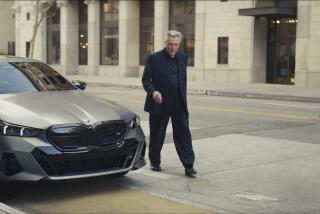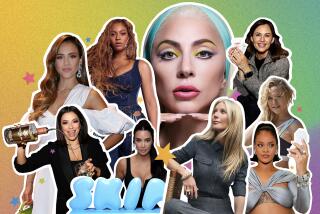Uh-Oh Sales : Despite Popularity of ‘Uh-Huh Girls,’ Diet Pepsi Is in a Slump
- Share via
When Diet Pepsi’s “Uh-Huh Girls” show up at an airport or shopping mall, they are often mobbed by autograph-seeking fans who sometimes break out in the “Uh-Huh” jingle.
So popular are the three Los Angeles women--who co-star with Ray Charles in a Diet Pepsi ad series--that last week Pepsi began filming an ad at Venice Beach without their co-star from the last 13 commercials.
For the record:
12:00 a.m. May 26, 1993 For the Record
Los Angeles Times Wednesday May 26, 1993 Home Edition Business Part D Page 2 Column 6 Financial Desk 1 inches; 27 words Type of Material: Correction
“Uh-Huh Girls”--Diet Pepsi’s “Uh-Huh Girls” were misidentified in a photo caption in Tuesday’s editions. The trio, pictured from left: Gretchen Palmer, Meilani Paul and Darlene Dillinger.
Pepsi estimates that the women, who have jetted from “Late Night With David Letterman” appearances to entertaining Pepsi clients at pre-Super Bowl parties, have generated more than $20 million in free publicity for the brand.
But similar to a phenomenon that vexed some other wildly popular campaigns for consumer products, the “Uh-Huh Girls”--a ‘90s version of the Supremes--have not produced increased sales for Diet Pepsi. Despite more than $100 million spent on the campaign to make sure that their faces are everywhere, supermarket sales of Diet Pepsi this year through mid-April were down 3.8% compared to last year. By contrast, Diet Coke dropped 0.3% during the same period, Beverage World magazine says.
“If you look at the numbers,” said Lawrence Adelman, analyst at the New York investment firm Dean Witter Reynolds, “it would be hard to say what benefit they’ve received from the campaign.”
Despite the “incredible awareness” of the campaign, said Larry Jabbonsky, editor of Beverage World magazine, Diet Pepsi sales have not grown “proportionate with ad awareness.”
Marketing experts say that hot ad campaigns don’t always light up sales. Sometimes the characters in ads are so entertaining that--while consumers consider them to be terrific comedians, singers or dancers--they miss the sales pitch altogether.
Most consumers don’t even realize the “Uh-Huh” ads are for Diet Pepsi, said Dave Vadehra, president of Video Storyboard Tests, a New York ad research firm. Although the campaign rated No. 2 last year in a survey of 22,000 consumers, nearly three-fourths of the consumers said they believed that the ad was for the Pepsi brand--and not Diet Pepsi.
“The ads never really tell me why I should buy Diet Pepsi instead of Diet Coke,” said Julie Edell, professor of marketing at Duke University.
Granted, sales of virtually all diet colas--including archrival Diet Coke--have been heading south for the last few years. And the so-called New Age soft drinks and bottled juices have been clawing away at the diet soft drink market. But if one of the prime jobs of advertising is to increase sales, the “Uh-Huh Girls” have not been doing that.
During the 1980s, it wasn’t unusual some years for sales of Diet Pepsi to grow at a double-digit pace. But over the last three years of the “Uh-Huh” campaign, sales have been disappointing.
“We’re not happy with the slowed rate of growth,” said Jeff Campbell, senior vice president at Pepsi. “But I can’t fault the campaign for the slowdown. It relates to all the new competitors out there.”
The biggest mistake that Diet Pepsi has made is to “underutilize” the “Uh-Huh Girls,” Campbell said. At first, he said, Pepsi executives did not realize that the three women--who all wear wigs and lip-sync their way through the Diet Pepsi song--had so much talent. But the women--Gretchen Palmer, Darleen Dillinger and Meilani Paul--are now seeking a recording contract and hope to eventually record their own Diet Pepsi spot.
They recently toured Japan and were such a hit there that a flashy picture of them now appears on all labels across Diet Pepsi bottles there. Only one other American performer has had his mug on a Japanese Pepsi bottle before them: Michael Jackson.
Pepsi executives will not reveal what they pay the three women, but their 1993 salary is said to be nearly four times what the company paid them in 1992. And for each public appearance the women make--at grocery stores or corporate meetings--Pepsi pays them an estimated $5,000.
“We’re participants in one of the greatest campaigns of the ‘90s,” said Dillinger, in an interview before the commercial shoot in Venice. “Nothing goes on forever,” she said, “but as long as they want us around, we’ll stick with them.”
Pepsi can take some solace in the fact that this is hardly the first campaign whose tremendous popularity has far exceeded its effect on a company’s bottom line.
Several years ago, a wildly popular campaign for Isuzu--featuring the lying Joe Isuzu character--clearly struck a chord with consumers. But Isuzu sales were disappointing, and the campaign was eventually dropped. And while the Eveready Bunny has emerged as one of the most beloved campaigns of the ‘90s, one researcher found that 40% of the consumers questioned said they thought the campaign was for Duracell.
Briefly . . .
Irvine-based Times Mirror Cable Television has handed its $4.5-million national ad and promotion account--formerly handled by Costa Mesa-based Salvati Montgomery Sakoda--to Burbank-based Grey Entertainment & Media. . . . The Los Angeles agency Larsen Colby has picked up the $500,000 account for the Beverly Center. . . . Cypress-based Secure Horizons is looking for a new agency for its estimated $3.5-million account that has been handled by the Santa Ana agency Baxter Stone. . . . Santa Monica-based Drew Advertising has picked up $2.5 million in new billings from three divisions of Avnet Inc.’s Electronics Marketing Group. . . . Los Angeles mayoral candidates Michael Woo and Richard Riordan will debate at the May 26th monthly meeting of the Advertising Club of Los Angeles at noon at the Beverly Hilton in Beverly Hills.
More to Read
Inside the business of entertainment
The Wide Shot brings you news, analysis and insights on everything from streaming wars to production — and what it all means for the future.
You may occasionally receive promotional content from the Los Angeles Times.










